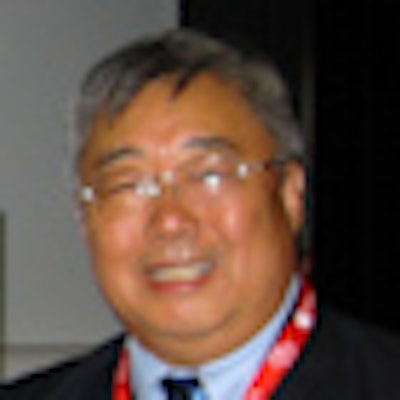
PARIS - China makes your head spin. How can a country with 60,000 radiologists be considered a start-up? And when the world seems to be flooded with increasingly high-end medical imaging equipment manufactured there, why is it so difficult for a Chinese hospital to get its hands on one of those scanners?
Welcome to the world of Dr. Jian-Ping Dai, past president of the Chinese Society of Radiology (CSR) and this year's winner of the Médaille Antoine Béclère at the annual congress of the French Radiology Society (SFR), les Journées Françaises de Radiologie (JFR). Awarded as recognition of a radiologist's life work and contribution to the profession, the honor was bestowed upon Dai during a plenary session of high ceremony attended by the leading lights of French radiology.
 Dr. Jian-Ping Dai (right) meets with Dr. Guy Frija, head of the imaging department at Hôpital Européen Georges Pompidou in Paris and former secretary general of the SFR. Photo courtesy of John Brosky.
Dr. Jian-Ping Dai (right) meets with Dr. Guy Frija, head of the imaging department at Hôpital Européen Georges Pompidou in Paris and former secretary general of the SFR. Photo courtesy of John Brosky.Dai's visit to Paris, which included a strong delegation from CSR, was the first official encounter between the two societies and the opening round for discussions aimed at establishing a formal relationship. Yet it was during a working session just ahead of the awards ceremony that Dai addressed French colleagues in an unusually open and frank discussion of the challenges facing his own society in the rapidly changing, and sometimes bewildering, landscape that is China today.
Each year, 20 million people move toward the urban centers of the east coast from the interior, roughly equivalent to all of Scandinavia invading Germany. The eastern seaboard already accounts for 41% of the Chinese population.
"This poses problems for our medical services," said Dai, adding that the growth rate in radiology practices is already soaring. Between 2009 and 2011, CT exams jumped 33%, MRI procedures posted a 70% increase, and digital subtraction angiography rose 68% due to a rapid adoption of interventional radiology therapies.
"We need help developing teleradiology services to better distribute expertise, with IT development and joint research efforts," he said, explaining the interest in stronger relations with the French society. "Stronger international relationships and increased academic activities are key for CSR to accelerate our progress to reaching international standards of practice. This is what we will be discussing this afternoon in our business session."
China has a long way to go. Here it is important to understand that the development of radiology in China was interrupted by the Japanese invasion in 1937, and that after 1950 it was modeled on the Soviet system exclusively with Russian-built equipment. CSR traces its beginnings to 1951. For 12 years, the profession stagnated during the Cultural Revolution, such that it was only in 1978 that CSR could begin rebuilding. Today, China has 100 university-centered hospitals where radiologists can be trained to support 17,500 national hospitals and a further 50,000 health institutions.
Currently, the educational focus is on building master programs and doctoral studies. There is not a residency stage of education for radiologists today in China. Graduates typically move directly from university into general practice, almost exclusively performing x-ray exams, and no formal training system exists for specialists.
CSR's planned reform of the educational process calls for five years of undergraduate study followed by three years of residency. For radiologists seeking further study for specialization, a two-year program will be established.
Dai currently serves as a professor of neuroradiology in the Beijing Neurosurgical Institute of Beijing Tiantan Hospital at the Capital University of Medical Services, is the founder of the Chinese Society of Neuroradiology, and introduced neurointerventional therapy in his country. He is a vice president of the Chinese Medical Association, the umbrella organization of which CSR is an affiliated group, as are all other professional medical societies. He was also in charge of the medical facilities during the 2008 Olympic Games in Beijing.



















